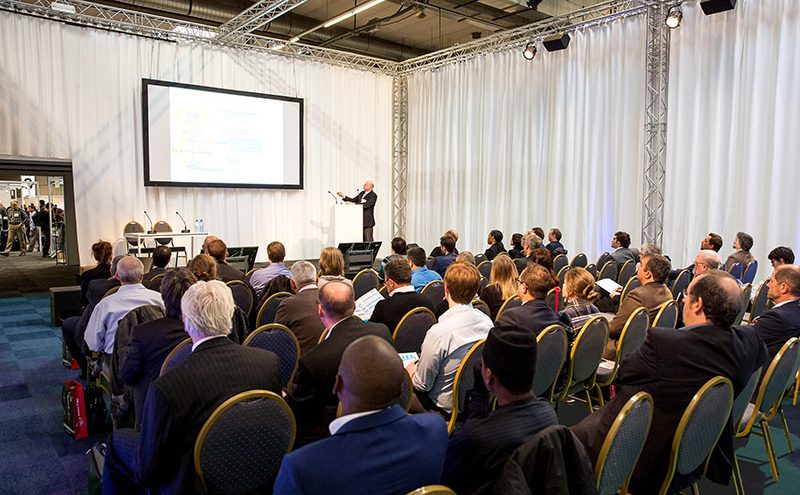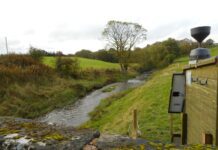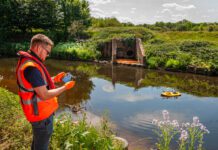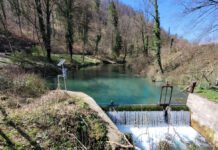
The organisers of WWEM 2018, the water, wastewater & environmental monitoring event (21-22 November, Telford) offer a preview of what’s on.
Covering testing issues such as microplastics, nutrients and herbicides, the event will look at all of the most topical subjects in water and wastewater analysis and monitoring. Many of these presentations are free to attend; as is the international exhibition that accompanies them.
The main purpose of the WWEM events, which began in 2005, is to provide the latest information on the regulations, standards, methods and technologies that relate to the testing and monitoring of water and wastewater. By bringing the whole sector together, including laboratory, online and field monitoring, the WWEM events provide a unique learning opportunity. As a focused event, visitors are able to meet regulators, accreditation organisations, members of Standards committees, academics, researchers, method developers, instrumentation experts and a wide variety of monitoring practitioners with environmental responsibilities.
Registration for WWEM 2018 is now open and all pre-registered visitors will benefit from free parking, refreshments and lunch, in addition to free entry to AQE 2018, the co-located air quality and emissions event. Visiting without pre-registration will cost £20/day.
The WWEM 2018 Conferences are CPD certified and with such a large selection of Conferences, Workshops, Seminars and a major international Exhibition, visitors are advised to plan their trip in advance.
Day 1: 21st November 2018
An Analytical Conference, (£75 + VAT) organised by the Standing Committee of Analysts (SCA), will be introduced by Prof K Clive Thompson who will describe the history of the SCA and outline future potential. An impressive list of eminent and highly experienced speakers will then address some of the most topical analytical issues. In addition to sampling and information requirements, the presentations will address issues such as the analysis of inorganics and metals, as well as the stability and uncertainty in organics analysis. The chemical analysis of soils and associated materials will also be discussed. The evolution of drinking water microbiology will be described, in addition to the role of on-line water quality monitoring in the production of high quality tap water.
The WWEM monitoring conference (£75 + VAT) will address some of the hottest topics in this sector, including on-line and at-site analysis, as well as the detection, counting and monitoring of microplastics. Following the ‘Blue Planet effect,’ the tide of public opinion on plastic waste and marine litter, is starting to turn, with inevitable political, and ultimately analytical consequences. Potential solutions to these challenges will be described in detail by Dr Andrew Mayes from the University of East Anglia, and Dr Claire Gwinnett from the University of Staffordshire. This will be followed by presentations covering online and at-site analysis in common environmental applications including, for example, real-time aquifer monitoring for shale oil and gas extraction. Improved and novel analytical solutions will be described including automated on-line monitoring for laboratory-grade monitoring of pollutants, and buoys fitted with smart sensors. Some of the new analytical techniques being covered include ion selective field effect transistors, on-site spectrometry, droplet-based microfluidic sensors, trace analysis of engineered silver nanomaterials, simple techniques for N and P with TOC, and the measurement of 5-day BOD in just 48 hours.
The Flow Forum Conference (free to attend) will include presentations from industry experts covering themes such as the maintenance of flow measurement equipment, and flow control and management, as well as providing an update on the latest developments in flow measurement.
The Pump Centre Conference (free to attend) is entitled: ‘Delivering BIM – Using Product Data across the UK Water Industry for Enhanced Efficiencies in Capital Delivery and Asset Management.’ As the UK water industry increasingly embraces BIM Level 2 during AMP 6 and AMP 7, there will be an increasing need for bespoke water industry product data templates. These will allow manufacturers to transfer product information in a digital format and in turn allow owner operators to directly import vital product information into their asset management system. This conference will provide an insight in to how this process works and what data templates have been created.
The Engineering Futures Launch Initiative was created to help micro and small businesses to attract apprentices. The objective is to provide an affordable brokering service to partner enterprises with local schools, colleges and universities to help level the playing field. Effectively under the scheme, Engineering Futures becomes an extension to each micro or SME compiling and presenting on behalf of each company, thereby substantially increasing their chances of attracting the right candidates. It is believed that the initiative could save enterprises over £3,000 per vacancy fill, in comparison with traditional recruitment. A further 20% discount will be offered to companies that sign on at WWEM 2018.
The WWEM Workshops (free to attend) on Day 1 have been mainly organised by WIPAC (Water Industry Process Automation & Control). Running throughout the day in rooms located within the Exhibition Hall, the workshops will cover a wide variety of themes including the measurement of flow and water quality as well as communications and data management.
The flow monitoring themes will include primary measurement devices, electromagnetic sensors, area velocity, radar, ultrasonic level and thermal mass flow measurement. Chemical analysis presentations will include ammonia, chlorine, turbidity, dissolved oxygen (and aeration control) and free cyanide detection in effluents.
A PROFIBUS Workshop is being organised by PI UK, an organisation which promotes the use of PROFIBUS in the UK. More recently it has added PROFINET and IO-Link to the range of technologies supported by the group and is now known as PROFIBUS and PROFINET International UK, or PI UK for short.
A SWAN Workshop (Smart Water Networks Forum) will bring together key players to collaborate and accelerate the use of data-driven solutions in water and wastewater networks. Visitors to this workshop will: gain insights on the most pressing, water service challenges; learn about the latest, integrated smart water and wastewater solutions; hear real-life water company case studies and engage with water company and industry leaders through interactive roundtables.
Day 2: 22nd November 2018
The WMSOC Conference (£75 + VAT) will run in the morning of the second day, and is entitled Rapid Microbiology Practical Applications. Organised by the Water Management Society, this conference will provide the latest advice on testing for Legionella and other water-borne pathogens. The speakers will share their experience in testing and monitoring techniques as well as outbreak management, with real-world case studies.
The WWEM monitoring conference (£75 + VAT) on day 2 will address a number of field and laboratory sampling and analysis themes. The first speaker, for example, will be Prof Gary Fones of Portsmouth University, who will describe the use of a passive sampler for monitoring pollutants such as herbicides in rivers. This will be followed by a presentation on automated sample preparation and GC-TOF for SVOC and pesticide analysis.
Organised by the Environmental and Food Analysis Special Interest Group (EFASIG) of the BMSS, a series of presentations will address the screening of wastewater. Speakers will cover recent advances in Ion Chromatography, Mass Spectrometry and online monitoring of VOCs from waste effluent by GC-FID and GC-TOF MS. Advanced deconvolution tools will be described for improved GC/MS identification rates. The screening of pharmaceutical and other medicinal compounds within environmental samples will be explained in addition to a rapid measurement of FOG (Fat, Oil and Grease) from wastewater using bench-top NMR.
Later in the afternoon, taste and odour challenges will be addressed, with a description of the world’s most sensitive detector, and then speakers from IME, University of Chicago will describe a ‘cyberphysical’ sensing system in India monitoring high frequency temporal and spatial variation in river water quality parameters.
The SWIG conference (£75 + VAT) is entitled: Industrial discharge monitoring & Smart water: extracting value & insights from data. There has been increasing awareness of the work by the Environment Agency to implement the ‘polluter pays’ principle, which is also at the heart of current government plans for a green Brexit. The aim of the morning session is to provide industrial dischargers, water companies, contractors and instrumentation providers with an update on systems which ensure compliance and deliver benefits from discharge monitoring. For example, Matt Dibbs from Meteor Communications will demonstrate remote water quality monitoring systems that can be deployed on sites without the need for power or data connection.
The afternoon session will explore the way that insights and value can be extracted from the huge amounts of data that is either already available or that will be generated by future deployments. The presentations will include an outline of a large scale water quality monitor deployment in Southern Water’s clean water distribution network.
The PROFIBUS Workshop (free to attend) will continue on day 2 as outlined above, and some of the WWEM Workshops from Day 1 will be repeated on day 2 – see www.wwem.uk.com for details.
International Exhibition
The WWEM 2018 Exhibition will feature organisations from around the world, offering an opportunity to see the whole sector in one place. There will be almost 150 stands representing more than 300 of the world’s leading providers of testing, analysis and monitoring equipment, and related services.
The WWEM exhibition offers free entry for pre-registered visitors, but for the first time, it will be co-located with AQE 2018, which means that visitors will be able to walk freely between the two events. Commenting on the 2018 line-up, WWEM Event Manager David Hellyer says: “It is difficult to think of any major brand in this sector that is not represented in the Exhibition Hall. However, it is also very gratifying to note the number of new and emerging companies that are also participating, so this will be a great opportunity for WWEM visitors to find out about all of the latest technologies, methods and techniques that have been developed since the last WWEM event in 2016.
In addition to the updates on regulations that will be provided by many of the conference speakers, both the WWEM and AQE exhibitions will feature a ‘Regulators Stand’ providing help and advice from the regulators of England, Wales, Scotland, Northern and Southern Ireland.
A Gala Dinner for both AQE and WWEM will take place on the evening of 21st November. The winners of various competitions will be announced at this event – such as the SWIG Early Career Poster Competition, the SWIG Photography Competition and the WIPAC Instrumentation Apprentice Competition. The Instrument Users Group will present two awards, both voted for by the water companies. These will be for: ‘The best after-sales service’ and ‘Breakthrough product.’ The guest speaker for this black tie event will be Mr Brian Blessed.
WWEM co-located with AQE 2018
Explaining the reasoning behind the decision to co-locate the two events, organiser Marcus Pattison says: “Many of the visitors to these events are responsible for environmental monitoring generally, rather than just water or air. Similarly, environmental researchers and consultants take a holistic approach to environmental monitoring, and water companies have to address issues such as confined space gas analysis and emissions from generators and incinerators.
“We have therefore made it free and easy to pass between the two events, but I would strongly urge those visitors that would like to attend both events to plan a 2 day visit, because it would be impossible to visit both exhibitions and attend the workshops or conferences of interest in just one day.
“In summary, for those visitors that come for both days and plan their time carefully, this is a unique opportunity to meet people they wouldn’t normally meet; learn things they didn’t realise they needed to know; and to see a world of environmental monitoring in one place.”






